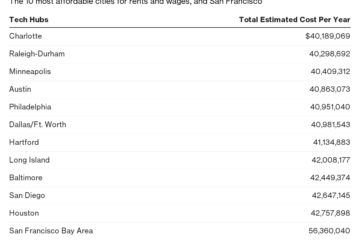In Potentially Risky Strategy, U.S. Startups Pile on Debt

(Bloomberg) —Persado Chief Executive Officer Alex Vratskides could raise venture funding. He’s just not sure he wants to.
His New York-based startup doubled annual revenue this year and is on track to break even in 2017. Valued at about $200 million in April, the marketing automation company counts Bain Capital and Goldman Sachs among its backers—a source of validation in the eyes of many venture investors.
But Vratskides thinks there’s a better way to reach the finish line: take on debt. “Interest rates are low, and you avoid dilution. It’s a no-brainer,” says Vratskides, who is angling to secure a loan of $30 million or so in the second half of 2017. “It is potentially our first preference going forward.”
Last year venture capitalists plowed a record $79 billion into startups at often unsustainable valuations. Enthusiasm waned in 2016, when fewer startups got funded, and those that did faced more scrutiny and tougher deal terms. While the market has recovered somewhat in the last few months, it’s down 10 percent from its high mid last year, according to the Bloomberg U.S. Startups Barometer, an index tracking funding and exits for private companies.
Venture deals in 2016—for all but the hottest startups, anyway—required founders to give up more equity in exchange for less money than they did last year. So, despite cautionary tales from tech blog GigaOm and game console maker Ouya, which both flamed out after failing to pay back lenders, U.S. startups have loaded up on debt, enabling them to borrow money without ceding a potentially lucrative stake.
No one publishes national data on venture debt, but a half dozen lenders provided numbers showing activity spiked in 2016. Silicon Valley Bank’s loan volume to venture-backed startups surged 19 percent during the past year to $1.1 billion for the quarter ending Sept 30. Wellington Financial made more than 10 new loans to venture-backed startups in 2016, double last year’s total. At Hercules Capital, annual volume is up and the average deal size increased 16 percent year-over-year to $15.6 million. TriplePoint’s volume is up more than 25 percent. Western Technology Investment CEO Maurice Werdegar called volume “robust” and described the lending environment as “hyper-competitive.”
Borrowing capital allows startups to postpone valuation negotiations that come with raising equity. Startups fear the prospect of selling shares at a lower price, known in the industry as a down round. “Folks don’t want to do down rounds or flat rounds,” says Haim Zaltzman, a partner at law firm Latham & Watkins LLP, which has handled well over 100 such loan transactions so far this year. “Debt allows you to get around that.”
Zaltzman compares this year’s activity with the debt boom in 2008, when venture funding slowed to a trickle. Silicon Valley Bank, the granddaddy of tech lending, says loan volume and value could have gone even higher. “What constrained us was discipline,” says Marc Cadieux, the bank’s chief credit officer who has seen competitors offer startups double what his bank would do and at “materially cheaper” rates. “There are limits to what we’re willing to do.”
Taking on debt can be risky. Unlike venture investors who typically bet one investment will hit big and compensate for duds, lenders get no upside if a startup succeeds. They require timely payments from all their companies, with interest that’s designed to provide the lender with a more predictable and less risky source of revenue than venture investing. When startups miss payments, as GigaOm and Ouya can attest and gaming company Mind Candy is finding out, lenders can be unforgiving.
“When things go bad, they go very bad, but there’s usually little information about the wind down,” says Mike Driscoll, founder and CEO of Metamarkets, an advertising technology startup founded in 2010 that has raised around $40 million. “Silicon Valley buries its dead very quietly.”
Despite the risk, Driscoll decided to take a loan this year. He says he didn’t consider tapping VCs again because another round would have diluted his shares too much. Driscoll says he ran a formal process, getting term sheets from five lenders along with lots of advice from Khosla Ventures and his other investors. The offers had interest rates ranging from 9 percent to 15 percent over two to five years, and the terms protecting the lenders varied. Financial covenants, especially ones permitting the lender to take control of the startup, were sometimes stringent.
One lender had a clause that would force Metamarkets to pay off the debt early if it failed to hit 80 percent of its revenue projection. Driscoll passed on that, opting instead for cleaner terms for a $14.25 million loan in October at an average rate of around 11 percent from Wellington Financial and City National Bank. He’ll use the cash to invest in Metamarkets’ cloud infrastructure, which should ultimately lower operating costs.
Although debt activity is up this year, the practice is hardly a new phenomenon. VCs have long arranged lines of credit for startups—which they can draw from, or not—at the time they invest to help them meet operating costs and ensure they don’t run out of cash between rounds.
Western Technology Investment names several hundred startups on its site as current debtors or equity investments, including insurance startup Oscar Health; Jet.com which was acquired by Wal-Mart Stores for $3.3 billion in August; and data mining giant Palantir Technologies. Another customer is car-buying site Beepi, which shut down its business outside California, cut 180 jobs and merged with another startup this month.
Matt Murphy, a partner at Menlo Ventures, says most companies he works with have some amount of debt. So long as the terms are structured properly, it can be a good way to minimize dilution and build to the next funding round, he says.
Latham Watkins’ Zaltzman expects the brisk pace to continue through next year as more mature companies seek options other than venture investment or going public.
“You don’t have to grow 20 percent or 30 percent every year to be a good candidate for debt credit,” he says, adding that some startups valued at north of $1 billion will fall into that category. “Some of these unicorns are limping, but they haven’t gone completely bust yet.”







No Comment